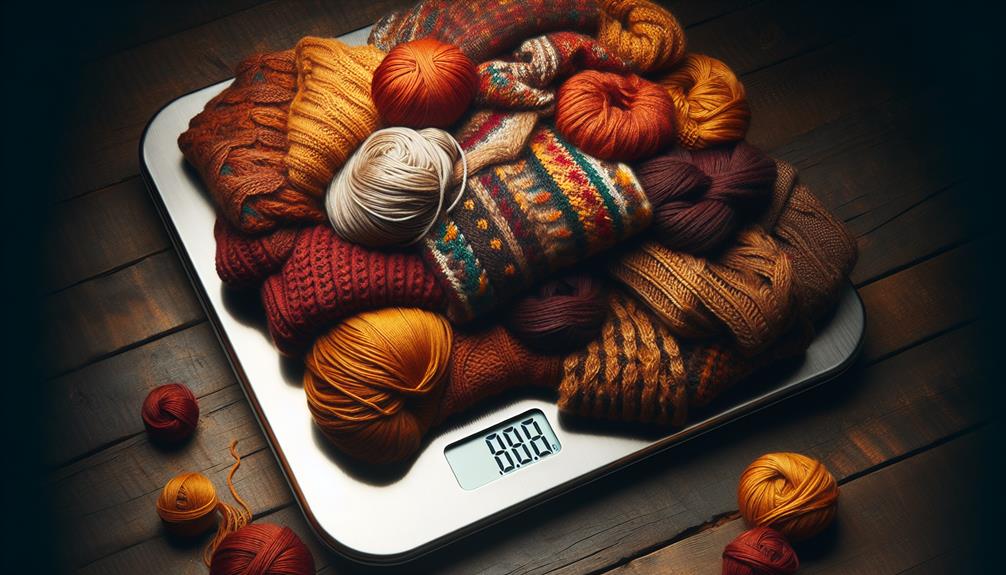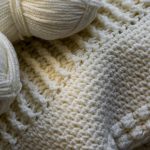As they say, when it comes to the weight of a sweater, it's not always cut and dry. Have you ever wondered just how much those cozy knits in your wardrobe tip the scales?
Well, let's unravel the mystery together. From the airy lightness of a cotton pullover to the substantial heft of a wooly jumper, each type of sweater has its own unique weight profile. But that's just the beginning of our exploration—there's a whole world of sweater weights waiting to be discovered.
Table of Contents
Key Takeaways
- Yarn type and knitting technique significantly impact sweater weight and feel.
- Sweater weight varies by material like wool, cashmere, cotton, and acrylic.
- Lightweight sweaters are ideal for layering, while heavyweight ones offer insulation.
- Proper weighing, storing, and maintenance techniques preserve sweater quality and longevity.
Factors Affecting Sweater Weight
When I pick out a sweater, the weight can vary based on the material and design. One important factor influencing the weight is the yarn type used. Different yarns have varying densities, with some being lightweight like cotton or bamboo, and others heavier like wool or alpaca. This choice impacts not only the feel of the sweater but also its overall weight.
Another vital aspect to take into account is the knitting technique employed. The method of knitting can affect how dense or airy the fabric turns out to be, consequently influencing the weight of the sweater. For instance, a tightly knit sweater will generally be heavier than one with a looser knit due to the amount of yarn used and the compactness of the stitches.
As a result, when selecting a sweater, paying attention to both the yarn type and the knitting technique can give you a better idea of the weight and feel of the garment. These factors work together to create a piece that not only looks good but also suits your preferences regarding weight and comfort.
Average Weight of Cotton Sweaters
Exploring the domain of cotton sweaters, one can uncover the average weights that this popular material typically carries. When it comes to cotton sweaters, the weight can vary depending on the sweater construction and sizing. Cotton sweaters are known for their breathability and comfort, making them a versatile choice for various occasions.
To give you a better idea of the average weight of cotton sweaters, I've compiled a table below outlining the approximate weights based on common sizes and styles:
| Sweater Size | Average Weight (ounces) |
|---|---|
| Small | 8-12 |
| Medium | 10-14 |
| Large | 12-16 |
| XL | 14-18 |
Keep in mind that these are general ranges and the actual weight can vary depending on the specific design and thickness of the cotton used in the sweater. Understanding the weight of your cotton sweater can help you make informed decisions when choosing the right one for your needs.
Average Weight of Wool Sweaters
Wool sweaters typically vary in weight depending on the type of wool and the thickness of the knit. When considering the weight of wool sweaters, factors such as sweater construction and weight distribution play a vital role. The weight of a wool sweater is influenced by the intricacy of its construction. For instance, cable-knit wool sweaters tend to be heavier than finely knit ones due to the additional yarn used in their creation.
Additionally, the weight distribution across a wool sweater can also impact its overall heaviness. Sweaters with dense patterns or bulky collars may have concentrated areas of weight, whereas simpler designs distribute the weight more evenly. Understanding these nuances in sweater construction and weight distribution can help in selecting a wool sweater that meets both style and comfort preferences.
Therefore, when evaluating the weight of wool sweaters, it's important not just the type of wool and knit thickness but also how the sweater is constructed and how weight is distributed throughout the garment.
Average Weight of Cashmere Sweaters
When it comes to cashmere sweaters, the weight can vary depending on the quality of the cashmere yarn used and the style of the sweater. Factors such as the thickness of the yarn, the design of the sweater, and any additional embellishments all contribute to the overall weight of the garment.
Understanding these factors can help you choose the perfect weight of cashmere sweater to suit your needs and preferences.
Cashmere Sweater Materials
Cashmere sweaters can vary in weight depending on the quality of the cashmere fibers used in their production. The weight of a cashmere sweater is influenced by the thickness and length of the luxury fibers as well as the knit construction. Here is a breakdown of the average weight of cashmere sweaters based on common quality categories:
| Quality Level | Weight (grams) | Weight (ounces) |
|---|---|---|
| Standard | 250-350 | 8.8-12.3 |
| Premium | 350-450 | 12.3-15.9 |
| Luxury | 450-600 | 15.9-21.2 |
Luxury cashmere sweaters, with longer and finer fibers, tend to be heavier due to the higher density of the material. The knit construction also plays a role in the overall weight of the garment.
Weight Variations
Exploring the weight variations of cashmere sweaters sheds light on their quality and construction. When it comes to the average weight of cashmere sweaters, factors like yarn composition and knitting techniques play a significant role.
Cashmere sweaters can vary in weight depending on the type of yarn used. Thicker yarns tend to result in heavier sweaters, while finer yarns can create lighter pieces that still offer warmth and softness. Additionally, the knitting technique employed influences the weight of the sweater. For instance, tightly knit cashmere sweaters may weigh more due to the denser fabric, while looser knits can result in lighter garments.
Understanding these nuances can help in selecting the perfect cashmere sweater based on personal preferences and needs.
Average Weight of Acrylic Sweaters
Acrylic sweaters typically weigh around 1 pound, making them a lightweight and comfortable option for everyday wear. As someone who appreciates well-made clothing, I find acrylic sweaters to be a versatile addition to any wardrobe. Here are a few key points to take into account when exploring the world of acrylic sweaters:
- Sweater Construction: Acrylic sweaters are often machine-knitted, which results in a consistent and even weave that enhances their durability.
- Durability: Despite their lightweight nature, acrylic sweaters are surprisingly durable and can withstand regular wear without losing their shape or color.
- Pricing: Acrylic sweaters are generally more affordable than their wool counterparts, offering a budget-friendly option without compromising on style.
- Brand Comparisons: Different brands offer varying quality and design options in acrylic sweaters, so it's worth exploring different brands to find the perfect fit for your style and preferences.
When looking for a reliable and lightweight sweater option, acrylic sweaters are a fantastic choice that combines comfort, style, and affordability.
Lightweight Vs. Heavyweight Sweaters
When comparing lightweight and heavyweight sweaters, it's important to take into account factors like warmth, comfort, and versatility to find the perfect option for your wardrobe.
Lightweight sweaters are ideal for layering options, allowing you to add warmth without feeling bulky. They're versatile pieces that can be easily styled for various occasions, from casual to semi-formal.
On the other hand, heavyweight sweaters provide more insulation and are great for colder climates where staying warm is a priority.
Regarding durability, heavyweight sweaters tend to be more robust and can withstand more wear and tear compared to their lighter counterparts. However, they may require more care during washing and storage to maintain their shape and quality.
Lightweight sweaters, while delicate, can be easier to care for but may need more frequent replacement due to their thinner materials.
Ultimately, the choice between lightweight and heavyweight sweaters depends on your personal style preferences, climate, and how you plan to incorporate them into your wardrobe.
Tips for Weighing and Storing Sweaters
To confirm your sweaters stay in top condition and are easy to find when you need them, proper weighing and storing techniques are essential. When it comes to maintaining your sweaters, attention to detail is key. Here are some tips for accurately weighing and storing your sweaters:
- Use a Digital Scale: For precise weighing accuracy, invest in a digital scale that can measure even small changes in weight.
- Fold, Don't Hang: To prevent stretching and misshaping, fold your sweaters neatly instead of hanging them in the closet.
- Avoid Direct Sunlight: Store your sweaters in a cool, dark place to prevent colors from fading and fibers from weakening.
- Use Breathable Storage Solutions: Opt for breathable storage solutions like cotton garment bags or cedar-lined drawers to prevent musty odors and keep moths at bay.
Frequently Asked Questions
Can the Weight of a Sweater Affect Its Warmth?
Absolutely, the weight of a sweater impacts its warmth. Lighter sweaters provide less insulation efficiency but are great for layering. Heavier ones offer more warmth on their own. Both have their benefits depending on the weather.
How Do Different Knitting Techniques Impact the Weight of a Sweater?
I've noticed that different knitting techniques impact a sweater's weight. Yarn selection plays a role; heavier yarns create heavier sweaters. Stitch patterns and density also affect weight, with intricate designs often resulting in a heavier garment.
Are There Any Eco-Friendly Materials That Are Lighter in Weight for Sweaters?
When it comes to sustainable fashion, eco-friendly options like bamboo, Tencel, and organic cotton are lightweight materials that reduce the environmental impact of sweaters. Incorporating these materials into designs promotes both style and sustainability.
Can the Weight of a Sweater Affect Its Price?
Weight can impact the price of a sweater. Quality materials often weigh more but increase the value. On the other hand, a lighter weight due to style choices can also influence pricing, especially for trendy designs.
How Do the Different Sizes of Sweaters Impact Their Weight?
When it comes to sweaters, size variations play a big role in weight. Different sizes can impact how much material is used, affecting overall weight. Additionally, material composition, weight distribution, and design elements all contribute to the final weight of a sweater.
- All About Spunbond Nonwoven Fabric and Its Uses - July 11, 2025
- The Ultimate FAQ on Nonwoven Fabrics - July 11, 2025
- Nonwoven Fabric Strength: What GSM Do You Need? - July 11, 2025







